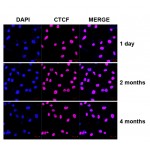| Reactivity: | Human |
| Applications: | WB, ELISA |
| Host Species: | Rabbit |
| Isotype: | IgG |
| Clonality: | Polyclonal antibody |
| Gene Name: | crystallin beta A4 |
| Gene Symbol: | CRYBA4 |
| Synonyms: | CYRBA4; CTRCT23; MCOPCT4; CRYBA4 |
| Gene ID: | 1413 |
| UniProt ID: | P53673 |
| Immunogen: | Recombinant fusion protein containing a sequence corresponding to amino acids 1-196 of human CRYBA4 (NP_001877.1). |
| Dilution: | WB 1:200-1:2000 |
| Purification Method: | Affinity purification |
| Concentration: | 1.23 mg/ml |
| Buffer: | Buffer: PBS with 0.01% thimerosal,50% glycerol,pH7.3. |
| Storage: | Store at -20°C. Avoid freeze/thaw cycles. |
| Documents: | Manual-CRYBA4 antibody |
Background
Crystallins are separated into two classes: taxon-specific, or enzyme, and ubiquitous. The latter class constitutes the major proteins of vertebrate eye lens and maintains the transparency and refractive index of the lens. Since lens central fiber cells lose their nuclei during development, these crystallins are made and then retained throughout life, making them extremely stable proteins. Mammalian lens crystallins are divided into alpha, beta, and gamma families; beta and gamma crystallins are also considered as a superfamily. Alpha and beta families are further divided into acidic and basic groups. Seven protein regions exist in crystallins: four homologous motifs, a connecting peptide, and N- and C-terminal extensions. Beta-crystallins, the most heterogeneous, differ by the presence of the C-terminal extension (present in the basic group, none in the acidic group). Beta-crystallins form aggregates of different sizes and are able to self-associate to form dimers or to form heterodimers with other beta-crystallins. This gene, a beta acidic group member, is part of a gene cluster with beta-B1, beta-B2, and beta-B3.
Images
 | Western blot analysis of various lysates using CRYBA4 Rabbit pAb (A15268) at 1:1000 dilution. Secondary antibody: HRP-conjugated Goat anti-Rabbit IgG (H+L) (AS014) at 1:10000 dilution. Lysates/proteins: 25μg per lane. Blocking buffer: 3% nonfat dry milk in TBST. Detection: ECL Basic Kit (RM00020). Exposure time: 30S. |
You may also be interested in:

